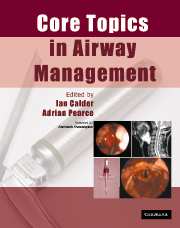Book contents
- Frontmatter
- Contents
- List of contributors
- Preface
- Acknowledgements
- List of abbreviations
- 1 Anatomy
- 2 Physiology of apnoea and hypoxia
- 3 Physics and physiology
- 4 Cleaning and disinfection of airway equipment
- 5 General principles
- 6 Maintenance of the airway during anaesthesia: supra-glottic devices
- 7 Tracheal tubes
- 8 Tracheal intubation of the adult patient
- 9 Confirmation of tracheal intubation
- 10 Extubation
- 11 Light-guided intubation: the trachlight
- 12 Fibreoptic intubation
- 13 Retrograde intubation
- 14 Endobronchial and double-lumen tubes, bronchial blockers
- 15 ‘Difficult airways’: causation and prediction
- 16 The paediatric airway
- 17 Obstructive sleep apnoea and anaesthesia
- 18 The airway in cervical trauma
- 19 The airway in cervical spine disease and surgery
- 20 The aspiration problem
- 21 The lost airway
- 22 Trauma to the airway
- 23 Airway mortality associated with anaesthesia and medico-legal aspects
- 24 ENT and maxillofacial surgery
- 25 Airway management in the ICU
- 26 The airway in obstetrics
- Index
25 - Airway management in the ICU
Published online by Cambridge University Press: 15 December 2009
- Frontmatter
- Contents
- List of contributors
- Preface
- Acknowledgements
- List of abbreviations
- 1 Anatomy
- 2 Physiology of apnoea and hypoxia
- 3 Physics and physiology
- 4 Cleaning and disinfection of airway equipment
- 5 General principles
- 6 Maintenance of the airway during anaesthesia: supra-glottic devices
- 7 Tracheal tubes
- 8 Tracheal intubation of the adult patient
- 9 Confirmation of tracheal intubation
- 10 Extubation
- 11 Light-guided intubation: the trachlight
- 12 Fibreoptic intubation
- 13 Retrograde intubation
- 14 Endobronchial and double-lumen tubes, bronchial blockers
- 15 ‘Difficult airways’: causation and prediction
- 16 The paediatric airway
- 17 Obstructive sleep apnoea and anaesthesia
- 18 The airway in cervical trauma
- 19 The airway in cervical spine disease and surgery
- 20 The aspiration problem
- 21 The lost airway
- 22 Trauma to the airway
- 23 Airway mortality associated with anaesthesia and medico-legal aspects
- 24 ENT and maxillofacial surgery
- 25 Airway management in the ICU
- 26 The airway in obstetrics
- Index
Summary
Introduction
Intensive care units (ICUs) were originally developed more than 50 years ago to offer patients prolonged respiratory support. Of course, more recently there have been great advances in the support of other organs. Nevertheless, ventilation and its accompanying airway management techniques remain at the centre of intensive care practice.
Endotracheal intubation
Indications for intubation
Respiratory failure is the main indication for endotracheal intubation in the ICU. However, there are other indications, including: control of partial pressure of carbon dioxide (PaCO2) in head injury patients, airway protection (e.g. during endoscopy), to allow investigations (e.g. bronchoscopy, computed tomography or magnetic resonance imaging scan), for transfer to another hospital or for uncontrolled seizures. Haemodynamic instability due to septic or cardiogenic shock is also an under-recognized indication for intubation.
Decision to intubate in respiratory failure
The decision to intubate should be primarily made on clinical grounds and the figures in Table 25.1 should be used as a guideline only. As an example the patient with chronic neurological weakness managed with nocturnal bilevel positive airway pressure (BIPAP) may normally have a (PaCO2) of 8.0 kPa and would almost certainly not require intubation. However, a young asthmatic patient who is deteriorating rapidly despite aggressive treatment may require intubation with a (PaCO2) of only 7.0 kPa. In general terms consideration should be given to the underlying diagnosis, the possibility of improvement with intensification of treatment, the trend in the clinical picture and most importantly whether the patient is tiring.
Organizational factors such as the availability of skilled support and the time of day are also often important considerations. Respiratory function and the ability to observe changes in respiratory function are decreased at night.
- Type
- Chapter
- Information
- Core Topics in Airway Management , pp. 191 - 196Publisher: Cambridge University PressPrint publication year: 2005



